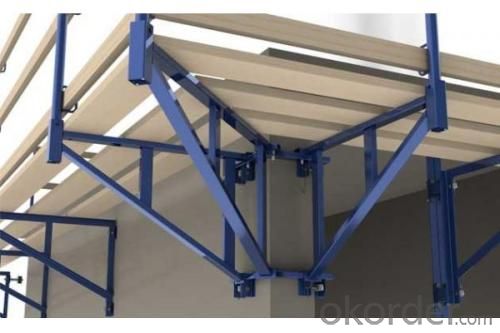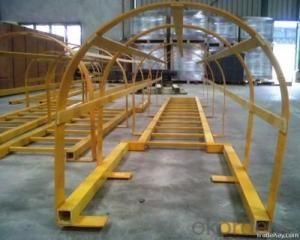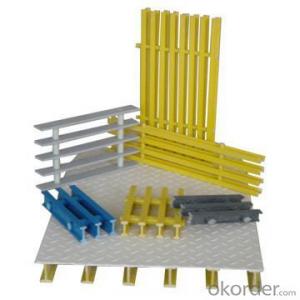Fiberglass FRP Panel Molded Plastic Floor Flooring
- Loading Port:
- Tianjin
- Payment Terms:
- TT OR LC
- Min Order Qty:
- 100 m
- Supply Capability:
- 70000 m/month
OKorder Service Pledge
OKorder Financial Service
You Might Also Like
Item specifice
PRODUCT DESCRIPTION
FRP flooring panel is a big size profile which is made by pultrusion technology and in holistic shape, it could form a continuours close plane by unique self-lock structure,which could be used as load structures in various corrosion environments and could replace wood plate, aluminum plate or steel plate etc.
The product could add natural color grit on the surface,which is safe for the anti-slippery,besides it could obtain
the natural appearance and no fadding for a long time.
FEATURES
1) Corrosion and chemical resistant
2) High strength-to-weight ratio
3) Fire retardant
4) Ergonomic
5) Slip-resistant
6) Anti-aging
7) Easy maintenance
SPECIFICATIONS
Item | Size(mm) | Weight(kg/m) |
01 | 25×25x3.2x3.2 | 0.52 |
02 | 32x32x3.2x3.2 | 0.68 |
03 | 38x38x4x4 | 0.98 |
04 | 50x50x4x4 | 1.36 |
05 | 50x50x5x5 | 1.67 |
06 | 50x50x6.3x6.3 | 2.06 |
07 | 60x60x7x7 | 3.2 |
08 | 100x100x6x6 | 4.56 |
09 | 38x38x7x7 | 2.02 |
PICTURES



FAQ
Q1:How Can I Get A Sample?
A1:You can get samples by communicate with our export sales.
Q2:How Long Is Delivery?
A2:Delivery time will be 30days according to order quantity.
Q3:What Is The MOQ?
A3:MOQ depends on different items.
Q4:What Is Our Normal Payments Terms?
A4:Our normal payment terms now is: T/T, L/C or western union,paypal
- Q:Can FRP pultrusion profiles be used in architectural or decorative applications?
- Certainly, architectural or decorative applications can definitely make use of FRP pultrusion profiles. FRP, an acronym for Fiber Reinforced Polymer, is a composite material that combines sturdy fibers like glass or carbon with a polymer resin matrix. This combination results in a material that is lightweight, durable, and resistant to corrosion, making it ideal for a variety of purposes, including architecture and decoration. The versatility of FRP pultrusion profiles lies in their ability to be manufactured in various shapes and sizes, making them highly adaptable for architectural and decorative uses. These profiles can be utilized to construct visually appealing structures such as columns, beams, and facades, all of which enhance the aesthetic appeal of buildings. Furthermore, FRP pultrusion profiles can be fabricated to imitate the appearance of other materials, such as wood or metal, enabling the creation of decorative elements that seamlessly blend into the overall design. Moreover, FRP pultrusion profiles offer several advantages over traditional materials commonly employed in architecture and decoration. They are lightweight, making them easier to handle and install, reducing labor costs. Additionally, they exhibit high resistance to corrosion, weathering, and UV radiation, ensuring long-lasting performance in outdoor applications. Furthermore, FRP profiles can be customized to meet specific design requirements, including color, texture, and surface finish, offering endless possibilities for creative expression. In summary, FRP pultrusion profiles are a viable choice for architectural and decorative applications. Their lightweight, durable, and customizable nature makes them suitable for a wide range of design needs, while their corrosion resistance guarantees longevity and low maintenance. Whether it is for structural support or decorative embellishments, FRP pultrusion profiles are an excellent option for enhancing the aesthetics and functionality of architectural and decorative projects.
- Q:Are FRP pultrusion profiles resistant to chemicals used in agricultural applications?
- Yes, FRP (Fiber Reinforced Polymer) pultrusion profiles are highly resistant to chemicals used in agricultural applications. FRP pultrusion profiles are made from a combination of reinforced fibers and a polymer resin matrix, typically polyester or vinyl ester. These materials provide excellent resistance to a wide range of chemicals commonly used in agriculture, such as fertilizers, pesticides, herbicides, and various acids. The inherent corrosion resistance of FRP pultrusion profiles makes them a preferred choice in agricultural applications where exposure to chemicals is common. Unlike traditional materials like wood, steel, or concrete, FRP profiles do not deteriorate or degrade when exposed to aggressive chemicals. This resistance ensures that the profiles maintain their structural integrity and performance over a long lifespan, even under harsh agricultural conditions. Furthermore, FRP pultrusion profiles offer superior resistance to corrosion, moisture, UV radiation, and temperature fluctuations. These properties make them highly durable and suitable for a wide range of agricultural applications, including structural supports, fencing, grating, decking, and irrigation systems. It is important to note that while FRP pultrusion profiles are highly resistant to chemicals, they may still experience some level of degradation or staining when exposed to extremely concentrated or highly aggressive chemicals. Therefore, it is recommended to consult with the manufacturer or supplier to ensure that the specific chemicals used in the agricultural application are compatible with the chosen FRP pultrusion profiles.
- Q:Are FRP pultrusion profiles resistant to chemical spills or leaks?
- Yes, FRP (Fiber Reinforced Polymer) pultrusion profiles are highly resistant to chemical spills or leaks. One of the key advantages of using FRP as a construction material is its exceptional chemical resistance. FRP profiles are made by impregnating continuous fibers with a thermosetting resin, resulting in a strong and durable composite material. The resin used in FRP pultrusion profiles is typically selected based on the specific chemical environment in which the profiles will be exposed. This allows for customization and optimization of the composite's resistance to various chemicals. Additionally, the fibers used in FRP are generally chemically inert, further enhancing the resistance of the profiles to chemical spills or leaks. FRP pultrusion profiles have demonstrated excellent resistance to a wide range of chemicals, including acids, alkalis, solvents, and corrosive substances. They are commonly used in industries such as chemical processing, water and wastewater treatment, oil and gas, and marine applications, where exposure to aggressive chemicals is prevalent. In addition to their chemical resistance, FRP pultrusion profiles offer several other advantages. They are lightweight, yet possess high strength and stiffness, making them ideal for applications that require structural integrity. They are also non-conductive, non-magnetic, and have excellent electrical insulation properties. Overall, FRP pultrusion profiles are a reliable choice for environments where chemical spills or leaks are a concern, as they provide robust resistance to a wide range of chemicals, ensuring long-lasting performance and minimal maintenance requirements.
- Q:Can FRP pultrusion profiles be used in the construction of railway platforms?
- Yes, FRP (Fiber Reinforced Polymer) pultrusion profiles can be used in the construction of railway platforms. FRP pultruded profiles offer several advantages that make them suitable for this application. Firstly, FRP pultrusion profiles are lightweight yet highly durable. This makes them ideal for railway platforms as they can withstand heavy loads and frequent foot traffic without experiencing significant deformation or degradation over time. Secondly, FRP pultruded profiles have excellent corrosion resistance. This is particularly important for railway platforms, which are often exposed to harsh environmental conditions, including rain, snow, and salt. Unlike traditional materials such as steel or wood, FRP does not rust or rot, ensuring a longer lifespan for the platform. Additionally, FRP pultrusion profiles offer design flexibility. They can be customized to meet specific dimensional and structural requirements, allowing for the creation of platforms of various shapes and sizes. This versatility is beneficial for railway platforms, as they often need to be tailored to fit the available space and accommodate specific railway configurations. Furthermore, FRP pultrusion profiles have good electrical insulation properties. This is important for railway platforms, as they need to be electrically isolated from the tracks to prevent electrical shocks and ensure passenger safety. Lastly, FRP pultrusion profiles are easy to install and require minimal maintenance. They can be prefabricated off-site and quickly assembled on-site, reducing construction time and costs. Moreover, FRP does not require regular painting or sealing, saving both time and money on maintenance. In conclusion, FRP pultrusion profiles are a viable option for the construction of railway platforms due to their lightweight, durability, corrosion resistance, design flexibility, electrical insulation properties, and ease of installation and maintenance.
- Q:Can FRP pultrusion profiles be used in the renewable energy and solar power industry?
- The renewable energy and solar power industry can effectively utilize FRP (Fiber Reinforced Polymer) pultrusion profiles. These profiles possess several key characteristics that make them ideal for such applications. To begin with, the high strength-to-weight ratio of FRP pultrusion profiles is crucial in the renewable energy sector. They are lightweight yet strong, allowing them to withstand various environmental conditions while remaining cost-effective. Additionally, these profiles offer excellent corrosion resistance, ensuring durability and longevity in outdoor and potentially corrosive environments like solar power plants or wind farms. Moreover, FRP pultrusion profiles have outstanding electrical insulation properties, making them suitable for electrical applications commonly found in the renewable energy industry. Furthermore, these profiles can be easily customized into various shapes and sizes, enabling the design and engineering of complex structures required for solar power installations or wind turbine blades. Furthermore, FRP materials are non-conductive and non-magnetic, ensuring their safety for use in electrical and magnetic fields associated with renewable energy systems. In conclusion, FRP pultrusion profiles provide a combination of strength, durability, lightweight, corrosion resistance, and electrical insulation properties that make them highly suitable for use in the renewable energy and solar power industry.
- Q:Can FRP pultrusion profiles be used in renewable energy projects?
- Certainly, FRP pultrusion profiles are capable of being used in renewable energy projects. They possess a wide range of advantages that make them suitable for various applications within the renewable energy sector. To begin with, FRP pultrusion profiles are both lightweight and strong, which makes them ideal for utilization in wind turbine blades. The lightweight nature of FRP materials allows for increased efficiency in wind energy generation by reducing the load on the turbine, thus enhancing overall performance. Furthermore, the high strength-to-weight ratio of FRP profiles ensures durability and longevity, even in severe environmental conditions. Additionally, FRP pultrusion profiles display exceptional resistance to corrosion, which renders them suitable for employment in solar panel mounting structures and other components exposed to moisture and outdoor elements. This corrosion resistance ensures that FRP profiles maintain their structural integrity and performance over an extended period, diminishing the need for frequent maintenance and replacement. Furthermore, FRP pultrusion profiles can be customized to meet specific project requirements, providing flexibility in design and functionality. They can be easily molded into complex shapes and sizes, facilitating the creation of innovative and efficient solutions for renewable energy projects. Moreover, FRP materials are non-conductive and possess excellent electrical insulation properties, making them suitable for use in electrical enclosures and support structures for renewable energy systems such as solar power plants. In conclusion, FRP pultrusion profiles can be effectively utilized in renewable energy projects due to their lightweight, strong, corrosion-resistant, customizable, and electrically-insulating properties. These characteristics make FRP profiles a reliable and sustainable choice for various applications within the renewable energy sector.
- Q:Are FRP pultrusion profiles resistant to caustic soda?
- Yes, FRP (Fiber Reinforced Plastic) pultrusion profiles are typically resistant to caustic soda. Caustic soda, also known as sodium hydroxide, is a strong alkaline substance that can corrode certain materials. However, FRP pultrusion profiles are made of a combination of strong fibers (such as fiberglass) and a resin matrix (such as polyester or epoxy). This composite construction provides excellent resistance to chemicals, including caustic soda. FRP pultrusion profiles are often used in industries where exposure to corrosive substances is common, such as chemical processing, wastewater treatment, and mining. It is important to note that the specific resin used in the FRP profiles and the concentration and temperature of the caustic soda may affect the overall resistance.
- Q:Are FRP pultrusion profiles resistant to chemicals used in food packaging?
- Yes, FRP (Fiber Reinforced Polymer) pultrusion profiles are generally resistant to chemicals used in food packaging. FRP materials are known for their excellent resistance to a wide range of chemicals, including those commonly used in food packaging such as acids, bases, solvents, and oils. This chemical resistance makes FRP pultrusion profiles a suitable choice for applications involving contact with food packaging materials. However, it is important to note that the specific resistance of FRP profiles may vary depending on the formulation and type of resin used. Therefore, it is advisable to consult with the manufacturer or supplier to ensure that the chosen FRP pultrusion profiles are suitable for the specific chemicals used in the food packaging industry.
- Q:Are FRP pultrusion profiles suitable for the manufacturing of chemical pumps?
- Chemical pumps can benefit from the use of FRP pultrusion profiles. These profiles, composed of a combination of fiber reinforcements and a polymer resin matrix, offer numerous advantages that make them ideal for this manufacturing process. To start, FRP pultrusion profiles are highly resistant to corrosion. Chemical pumps often encounter corrosive substances that can cause damage to traditional metal components. However, the composition of FRP profiles allows them to withstand the corrosive effects of various chemicals. This durability ensures that chemical pumps remain functional and reliable for extended periods. Moreover, FRP pultrusion profiles possess impressive mechanical properties. Their strength-to-weight ratio means that they can handle high pressures and loads without adding excessive weight to the pump. This is especially important for chemical pumps that must perform heavy-duty tasks while maintaining their efficiency over time. Furthermore, FRP pultrusion profiles offer flexibility in design. Manufacturers can produce these profiles in different shapes and sizes, allowing for customization that meets specific pump requirements. This adaptability enables manufacturers to optimize the performance and efficiency of chemical pumps. Additionally, FRP pultrusion profiles are non-conductive, minimizing the risk of electrical accidents in chemical pump applications. This safety feature is crucial in ensuring a secure working environment. In conclusion, FRP pultrusion profiles are an excellent choice for manufacturing chemical pumps. Their corrosion resistance, exceptional mechanical properties, design flexibility, and electrical non-conductivity contribute to the longevity, efficiency, and safety of these pumps in various industrial settings.
- Q:Are FRP pultrusion profiles resistant to saltwater corrosion?
- Yes, FRP (Fiber Reinforced Plastic) pultrusion profiles are highly resistant to saltwater corrosion. The corrosion resistance of FRP profiles is one of their key advantages over traditional materials such as steel or aluminum. The combination of the reinforcing fibers and the resin matrix used in FRP pultrusion profiles makes them inherently resistant to the corrosive effects of saltwater. FRP profiles are composed of a mixture of glass or carbon fibers embedded in a thermosetting resin. These materials do not react with saltwater, preventing the corrosion that occurs in metals when exposed to saltwater for an extended period. Additionally, the resin matrix used in FRP profiles provides a protective barrier that further prevents saltwater from reaching the reinforcing fibers. The corrosion resistance of FRP pultrusion profiles makes them ideal for applications in marine environments. They are commonly used in structures such as seawalls, dock fenders, offshore platforms, and marine vessels. The durability of FRP profiles in saltwater environments ensures long-term performance and reduces the need for frequent maintenance or replacement. However, it is important to note that while FRP pultrusion profiles are highly resistant to saltwater corrosion, they may still be affected by other factors such as UV radiation or chemical exposure. Therefore, it is essential to consider the specific environmental conditions and consult with manufacturers or experts to select the most suitable FRP profile for a particular application.
1. Manufacturer Overview |
|
|---|---|
| Location | |
| Year Established | |
| Annual Output Value | |
| Main Markets | |
| Company Certifications | |
2. Manufacturer Certificates |
|
|---|---|
| a) Certification Name | |
| Range | |
| Reference | |
| Validity Period | |
3. Manufacturer Capability |
|
|---|---|
| a)Trade Capacity | |
| Nearest Port | |
| Export Percentage | |
| No.of Employees in Trade Department | |
| Language Spoken: | |
| b)Factory Information | |
| Factory Size: | |
| No. of Production Lines | |
| Contract Manufacturing | |
| Product Price Range | |
Send your message to us
Fiberglass FRP Panel Molded Plastic Floor Flooring
- Loading Port:
- Tianjin
- Payment Terms:
- TT OR LC
- Min Order Qty:
- 100 m
- Supply Capability:
- 70000 m/month
OKorder Service Pledge
OKorder Financial Service
Similar products
New products
Hot products
Related keywords































